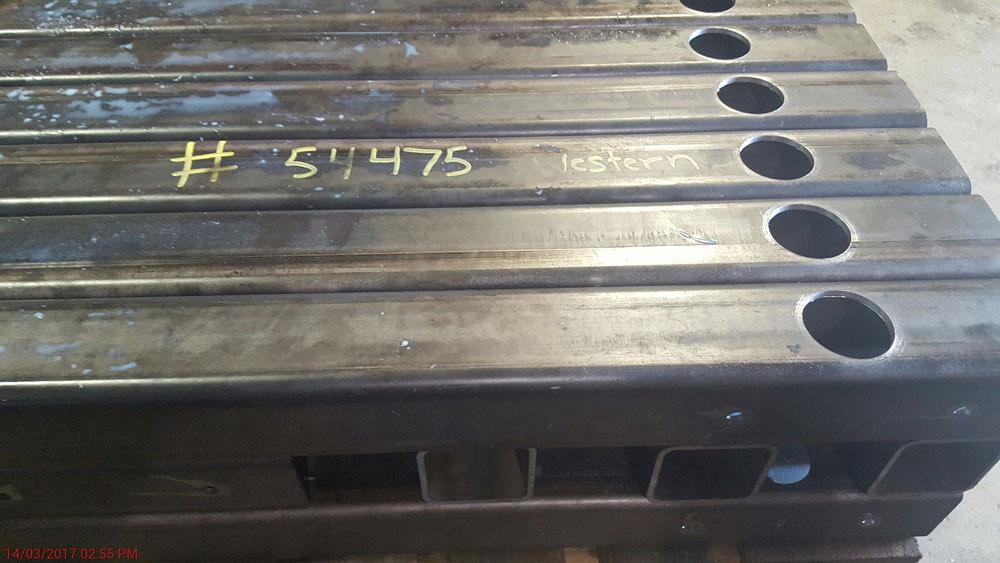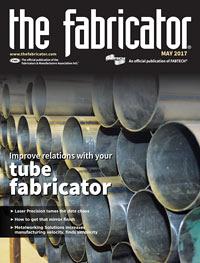Senior Editor
- FMA
- The Fabricator
- FABTECH
- Canadian Metalworking
Categories
- Additive Manufacturing
- Aluminum Welding
- Arc Welding
- Assembly and Joining
- Automation and Robotics
- Bending and Forming
- Consumables
- Cutting and Weld Prep
- Electric Vehicles
- En Español
- Finishing
- Hydroforming
- Laser Cutting
- Laser Welding
- Machining
- Manufacturing Software
- Materials Handling
- Metals/Materials
- Oxyfuel Cutting
- Plasma Cutting
- Power Tools
- Punching and Other Holemaking
- Roll Forming
- Safety
- Sawing
- Shearing
- Shop Management
- Testing and Measuring
- Tube and Pipe Fabrication
- Tube and Pipe Production
- Waterjet Cutting
Industry Directory
Webcasts
Podcasts
FAB 40
Advertise
Subscribe
Account Login
Search
Diversity in metal manufacturing drives growth at Valley Fab
Oregon fabricator thrives with diverse processes, revenue streams
- By Tim Heston
- May 1, 2017
- Article
- Machining

Valley Fab Corp. offers not just welding, cutting, and forming, but also machining. Image courtesy of Valley Fab Corp.
It’s a typical weekend gathering of friends and acquaintances, and then you hear the question that inevitably leads to confusion.
“So, what do you do?”
“Oh, I’m in manufacturing.”
“That’s great. What do you make?”
“We fabricate sheet metal and plate for various industries.”
“Oh. Wait. What?”
The conversation goes downhill from there. Ironically, the more straightforward a person’s answer to the “What do you make?” question, the more tumultuous and less sustainable his employer is likely to be. If a company makes only truck chassis, it’s in trouble when the trucking industry tanks.
Sonny Yakis wouldn’t have a straightforward answer to that question. He’s general manager at Valley Fab Corp., a company that, like many others in this business, is difficult to pigeonhole.
The 70-employee organization in Brooks, Ore., amid the rolling farmland north of Salem, fabricates Water Master and Evergreen hose reel irrigators, truck equipment, structural projects, and components for cellphone towers.
That’s the easy answer, but it isn’t the full story. What began as a small job shop in the 1980s has evolved into a business that sells products to a diverse customer base that provides diverse revenue streams served by diverse metal manufacturing technologies—not just laser and plasma cutting, press brake bending, and welding, but also machining. The last includes a few vertical machining centers, a drill line, and a new drilling and milling center suited for Valley Fab’s high mix of fabrication work.
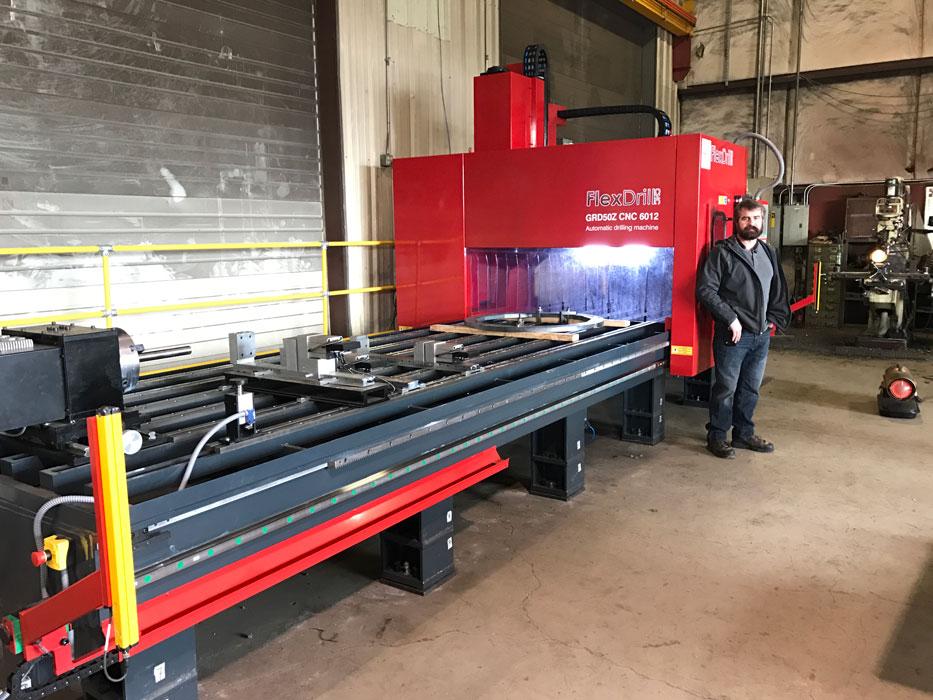
Valley Fab Vice President Leo Yakis (brother of General Manager Sonny Yakis) stands by a newly purchased drilling and milling machine. Photo courtesy of FlexDrill CNC.
That’s a mouthful, but a common theme winds through it all: diversity.
Diverse Customers
It’s no secret that custom fabrication can be highly susceptible to high revenue concentration. According to the most recent “Financial Ratios & Operational Benchmarking Survey” from the Fabricators & Manufacturers Association, on average fewer than five customers provide more than half the revenue for a typical fabricator. To rectify this imbalance, shops strive to diversify their customer base.
Still, it’s not just about the amount of revenue, but also how it flows in, and it’s rarely a consistent stream. Large projects, work for product lines, and everything from custom one-offs to blanket orders—the money for all of this comes in at different amounts and intervals. Have too much of one type of revenue, and life can become difficult, even if that revenue comes from umpteen markets across the economic spectrum.
To this end, Valley Fab is diversified on all fronts, and it did it not just by playing in the custom fabrication space, but also by forming partnerships with established brands. In 2013 it formed a joint venture with Workman & Sons, a provider of various products for the hauling business, including hoists, flatbeds, dump bodies, and trailers.
“Workman is the sales company,” Yakis said, “and Valley Fab is the manufacturer of its products.”
Back in 2003 the fabricator spun off a sister company called Newave Tower Components, which distributes components for cellphone towers. That business has a warehouse in Arizona, one in Oregon, and another in Washington state.
Valley Fab supplies about 90 percent of the components that Newave sells, fabricated just in time to replenish carefully managed stock. Sure, if the company sells 50 units of a product during a month, Newave will make sure it keeps 100 in stock to account for demand spikes. But for the most part, Newave doesn’t overstock components, considering how quickly tower components can become obsolete. The same strategy goes for products under the Workman brand.
Valley Fab also has the irrigator product line and associated components. Combine this with custom industrial and structural fabrication, and you have a sustainable mix of revenue sources.
Revenue is not just sustainable, it’s growing. Sales have grown by 15 to 20 percent annually over the past three years, and Yakis expects that growth rate to continue over the next few years.
Diverse Processes
Valley Fab’s metal manufacturing has evolved to become a headwater that feeds the company’s various value streams. Although it does fabricate product lines, its day-to-day operation resembles that of a typical custom fabricator, fulfilling the orders that come in the door. It’s just that those orders may be for a custom architectural project, an irrigator, or for Workman or Newave products.
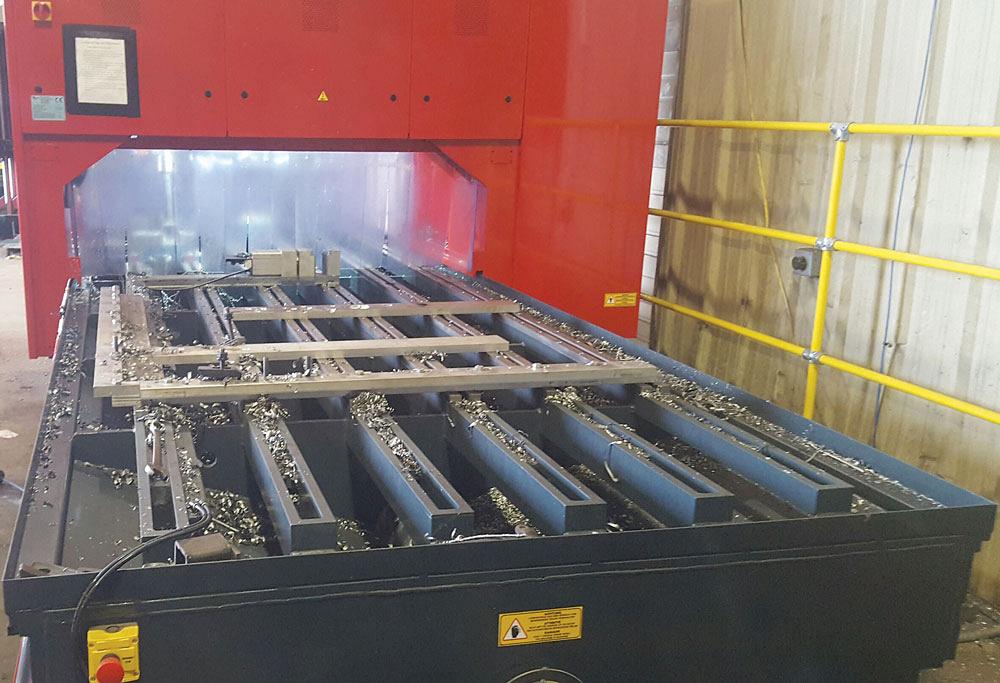
Valley Fab’s drilling and milling machine has a 20-ft. bed that is suitable for large workpieces and multiple smaller ones. Photo courtesy of Valley Fab Corp.
To process all these jobs efficiently first requires diverse technologies, both fabrication and machining. Like other fabricators, Valley Fab doesn’t specialize in machining-exclusive work, but instead has a machine shop to support the fabrication operation. The company has a few vertical machining centers and a few lathes, but it doesn’t have the work to purchase a horizontal machining center.
That said, like a lot of custom and structural fabricators, Valley Fab does process a lot of large components that require precision holes and pockets. The company has had a drill line for years, and the machine is still effective in drilling multiple holes in plates, angle iron, and beams.
“But we couldn’t do slots,” Yakis said. “It’s only for drilling.”
The fabricator needed to expand its milling capability in larger parts, and managers examined the alternatives. The company has a plasma table, and several years ago managers considered the option of making it a multifunction burn table with drilling and milling capabilities, allowing for countersinking and contour beveling. It also would have minimized handling, considering one machine would perform multiple operations.
But Valley Fab wanted to offer milling on plate as well as structural tube and other workpiece geometries. Most significant, a multifunction machine didn’t suit Valley Fab’s high product mix. Milling and drilling on the plasma table would have effectively reduced the shop’s plasma cutting capacity and created bottlenecks during periods of peak demand. Jobs requiring only plasma cutting would sit in queue, waiting for the long cycle times of multifunction jobs (cutting, milling, drilling, tapping) to complete.
Ultimately the shop invested in a FlexDrill large-workpiece drilling and milling center with a work envelope of 20 by 4 feet. This gives Valley Fab the ability to drill holes on plate, beam, bar, and tube, as well as bore, mill, tap, bevel, and chamfer. Yakis added that the company hopes that “[with these new] capabilities, we will expand into generating revenue exclusively from machining.
“We now have 20 feet of machining space,” Yakis continued. “So now we can set up multiple parts at one time, which is great if we’re doing repetitive work.” For instance, if the shop receives an order for 500 parts (a large-volume job for Valley Fab), even if each part is several feet long, the machinist can fixture five or more parts at once across the length of the work envelope.
Certain hole-intensive jobs still run on the company’s dedicated drill line. This includes some 1.25-in.-thick, 6- by 30-ft. plates destined for cell towers that each require 30 precision-drilled holes. But other jobs, including those that call for both precision holes as well as pockets, countersinks, bevels, and other machined geometries, are processed on the drilling and machining center.
Focus on the Now
Valley Fab deals with a challenge many fabricators face. It has diverse customer needs that sometimes hurt manufacturing efficiency; for example, a rush job that breaks into production, a last-minute order change, or a quantity change. And like many fab shops, Valley Fab’s scheduling wasn’t perfect. The fabricator went so far as to hire a consultant who helped the company focus and refine its scheduling efforts. Specifically, the consultant helped the organization focus on the now.
“We needed to focus on what we need to produce now, and not worry about two weeks from now,” Yakis said. “We took the initiative and found a [software] company that was willing to develop a product and refine it to our needs.”
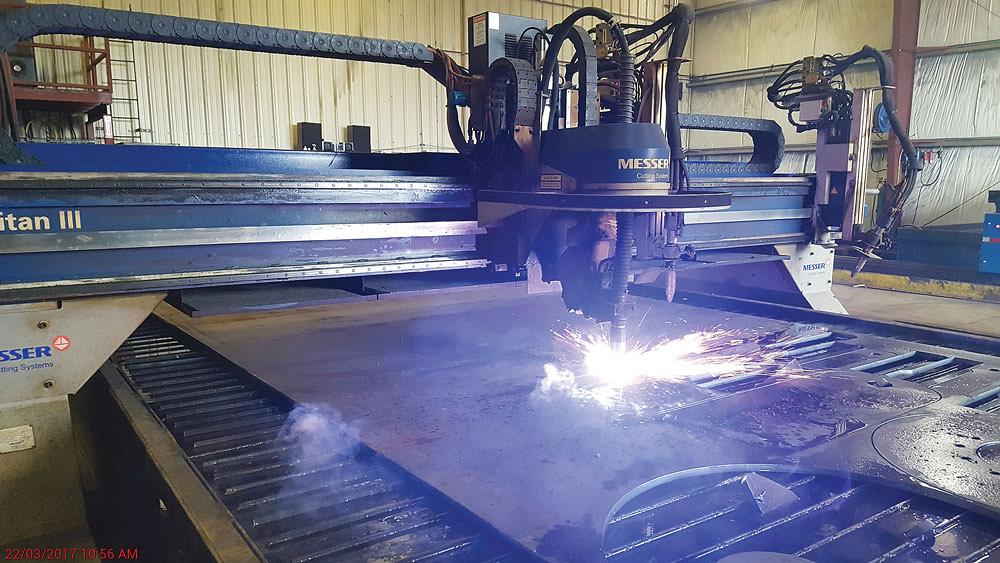
The company has a plasma and oxyfuel torch on its burn table. It considered adding drilling and milling options, but opted instead for a separate system. Photo courtesy of Valley Fab Corp.
The shop’s custom, cloud-based scheduling software focuses on “the now”—that is, what the shop needs to complete immediately. Sure, if it looked far out into the future, it could make more efficient use of shop resources—at least that’s the traditional thinking. In Valley Fab’s world, demand changes dramatically. Why tie up manufacturing capacity to fulfill what is, in essence, an estimation of future demand? And even if that demand prediction were accurate, producing ahead would just flood the floor with work-in-process.
Yakis clarified that the scheduling tool applies to the fabrication operation only. Its warehouse managers for its product-line businesses still maintain adequate stock levels—just enough, but no more than just enough—so they can respond quickly to customer demand. But when they submit an order to the fabrication operation with a due date, the scheduling tool doesn’t release it to the shop until it must (though it does release jobs earlier to the burning table to enhance nesting efficiency). The same could be said for demand coming from any revenue stream, be it custom fab or irrigator products or anything else.
As Yakis put it, “The software allows us to focus on what we need to finish today, and attack those issues, versus the issues that haven’t arrived yet. If we need the item today, we finish it today.”
This sums up the fabricator’s approach. It’s a strategic way to react to the varying demands of its diverse customer base. That diverse customer base doesn’t just offer sector diversity, but diversity in the kinds of work the fabricator performs, from large one-off projects to repeat orders. All this helps make the entire operation sustainable and ready for future growth.
Valley Fab Corp., 503-792-3739, www.valleyfabcorp.com
FlexDrill CNC, 419-739-6455, www.flexdrillcnc.com
About the Author

Tim Heston
2135 Point Blvd
Elgin, IL 60123
815-381-1314
Tim Heston, The Fabricator's senior editor, has covered the metal fabrication industry since 1998, starting his career at the American Welding Society's Welding Journal. Since then he has covered the full range of metal fabrication processes, from stamping, bending, and cutting to grinding and polishing. He joined The Fabricator's staff in October 2007.
subscribe now

The Fabricator is North America's leading magazine for the metal forming and fabricating industry. The magazine delivers the news, technical articles, and case histories that enable fabricators to do their jobs more efficiently. The Fabricator has served the industry since 1970.
start your free subscription- Stay connected from anywhere

Easily access valuable industry resources now with full access to the digital edition of The Fabricator.

Easily access valuable industry resources now with full access to the digital edition of The Welder.

Easily access valuable industry resources now with full access to the digital edition of The Tube and Pipe Journal.
- Podcasting
- Podcast:
- The Fabricator Podcast
- Published:
- 04/16/2024
- Running Time:
- 63:29
In this episode of The Fabricator Podcast, Caleb Chamberlain, co-founder and CEO of OSH Cut, discusses his company’s...
- Trending Articles
Tips for creating sheet metal tubes with perforations

Are two heads better than one in fiber laser cutting?

Supporting the metal fabricating industry through FMA

JM Steel triples capacity for solar energy projects at Pennsylvania facility

Omco Solar opens second Alabama manufacturing facility

- Industry Events
16th Annual Safety Conference
- April 30 - May 1, 2024
- Elgin,
Pipe and Tube Conference
- May 21 - 22, 2024
- Omaha, NE
World-Class Roll Forming Workshop
- June 5 - 6, 2024
- Louisville, KY
Advanced Laser Application Workshop
- June 25 - 27, 2024
- Novi, MI
























